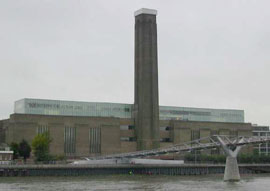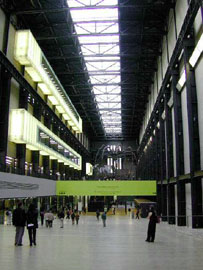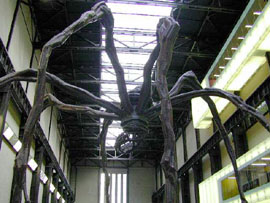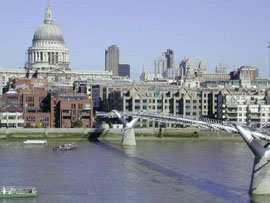Museum Tour: The Tate Modern
After our fifth hand of blackjack in my office, junior reporter Junko was eating my lunch. I wasn't doing well with my card play either. A curry and rice special is one thing, but the loss of my personally autographed Tony Blair picture and a number of memorabilia items from the Millennium Dome is entirely another.
 She held up the 8x10 glossy and asked, "So how did you get Mr. Blair to sign this picture?"
She held up the 8x10 glossy and asked, "So how did you get Mr. Blair to sign this picture?"
"Oh that, well when I was at Buckingham Palace for tea and biscuits, I just asked the Queen if she could pull a few strings for a short meeting with the grinning pixie. After that, doors just started opening, literally." I spread my arms apart and leaned forward in my chair to indicate the size of the Queen's accommodation.
"So she tossed you," she snickered. "What happened next?"
"Yeah, uh well," I said in slumping back into my chair, "it just so happens that it was Tony's day to park the cars out front. So on my way out, before he handed me my keys, I gave him my proposal on behalf of my Daiei-backed consortium to take the Millennium Dome off his hands."
"Daiei? Many of their top dogs were recently implicated in insider stock trading," she said.
"Say, now that I think about it, a bunch of their directors did seem rather rushed to want to shift some cash out of the country when I pitched the job initially. But that's neither here nor there..."
"As I recall, your impressions of the Dome weren't all that positive. Why buy it?"
 "The world's largest karaoke parlor doesn't sound appealing? During my stay, I already started recruiting waitresses. You know, part of the necessary R&D."
"The world's largest karaoke parlor doesn't sound appealing? During my stay, I already started recruiting waitresses. You know, part of the necessary R&D."
"Didn't you do anything else in London other than ogle girls and go to the Millennium Dome?"
I went into the newsroom to retrieve a cup of coffee - black, no sugar. I returned to my chair and lit up a smoke.
If there were ever any reputed artist's works more questionable than the pretentiousness of Marcel Duchamp's "ordinary objects," it is that of Mark Rothko. Any chance that the acclaimed sense of inner peace and calm reputed by the master of Testor's spray paint on canvas could be properly conveyed to the viewer is continually overridden with thoughts of: "If I spend 10 minutes to paint up some enlarged versions of my bathroom tile with supplies from my local hobby store, can I display them in a respected museum of art?" Of course, this must be the point. But for those wishing to entertain this conundrum, London's Tate Modern gives such an opportunity in its Landscape/Matter/Environment Gallery.
Like the skepticism often levied on many works of contemporary art at first glance, the Tate Modern's building itself - complete with many of its former factory characteristics intact - is likely to initially be looked at with similar askance. In the end though, the building is the real attraction. But the artwork as a whole is not so bad either.
The Tate Modern sits at the former home of the oil-fired Bankside Power Station. It is a recent addition to the Tate's family of highly regarded collection of museums scattered across Britain. The building was originally designed by Sir Giles Gilbert Scott in 1947. Then in 1981, fresh on the heels of sky high petrol prices in the late 1970s, the plant was relegated as redundant. So there it sat at the edge of the Thames, its large mono chimney extending 99 meters into the air and staring across the river at St. Paul's Cathedral, until 1995.
 Swiss architectural firm Herzog & de Meuron then redesigned the building for its use as a museum while keeping some remnants of its industrial past intact; interior steel columns with rust and rivets, the original bricks for the walls, and two large gantry cranes running along the roof. Additionally, an eerie drone can be heard in selected areas of the building, emanating from a switch house still in operation by London Electricity.
Swiss architectural firm Herzog & de Meuron then redesigned the building for its use as a museum while keeping some remnants of its industrial past intact; interior steel columns with rust and rivets, the original bricks for the walls, and two large gantry cranes running along the roof. Additionally, an eerie drone can be heard in selected areas of the building, emanating from a switch house still in operation by London Electricity.
But the site's past as an energy producer was not its beginning. Descriptions of the surrounding area, including the former nearby site of the Globe Theater, run rife with ruthless tales from when it was host to bull and bear fights five hundred years ago. These and numerous other historic anecdotes are told through handsets in the reading and resting areas of the museum's third floor.
The third floor is also a good place to look down upon the latest sculpture works of Louise Bourgeois, situated on the first floor of the large Turbine Hall. The Turbine Hall is a completely open space that occupies one half of the entire building. With the Hall extending the entire height of the building from the floor to a lancet window ceiling, the four large rusted metal works by Bourgeois are displayed below in natural light. The most interesting of the four is Maman. It is a medium tree-sized arthropod-looking piece located on a small extension platform of the museum's second floor that, as described by the artist, "is supposed to snare visitors." The other three are located on the first floor of the Hall and are named I Do, I Undo, and I Redo. Each consists of a two-story twisting staircase with a viewing platform, chair, and strategically mounted mirrors at the top. After the visitor ascends to the lofty perch, he can view others, and they him, as he views himself.
 But for those who like to view art rather than be a part of it, the museum has extensive displays of modern and contemporary works divided into four sections covering three of the museum's seven floors.
But for those who like to view art rather than be a part of it, the museum has extensive displays of modern and contemporary works divided into four sections covering three of the museum's seven floors.
The construction material used in the flooring of the third floor keeps with the industrial theme as it is of untreated wood interspersed with ventilation gratings. This rustic approach works well with the displays of Jasper Johns' odes to his favorite beer, Francis Picabia's wonderfully confusing household paint on canvas, and Lichtenstein's life-size household interior paintings.
The fourth floor features special exhibition spaces, an espresso cafe, and a viewing platform. The platform looks out over the Thames and the recently constructed Millennium Bridge, seemingly linking the museum with St. Paul's Cathedral. But due to possible design flaws, the only thing crossing the bridge now is some cold wind.
Equally chilling are some of the figures in the Nude/Action/Body Gallery of the fifth floor. But such coldness can be pleasant, as in the distorted and blurred bodies of Francis Bacon's paintings. Also nice is the ability of such sculptures as Modigliani's "Head" and Matisse's "Back" series of bronze works to stand up even in the company of Rodin's "The Kiss."
The cafe is a nice place for relaxation amid views of the Thames. Duchamp and Rothko probably both do just that. Sit, sip, laugh at confused guests, and watch the wind blow across the river.
I emptied my cup and Junko started shuffling the cards for the next hand.
 "You know," I said, "there is one thing about my trip that I found a bit puzzling. On the approach to Heathrow, JAL decided to play Glenn Miller's "Moonlight Serenade" over the sound system as we passed over the very waters that the bandleader's plane is thought to have crashed in."
"You know," I said, "there is one thing about my trip that I found a bit puzzling. On the approach to Heathrow, JAL decided to play Glenn Miller's "Moonlight Serenade" over the sound system as we passed over the very waters that the bandleader's plane is thought to have crashed in."
"He died flying from London," she said. "You were flying to London."
"Oh right. Damn me for not having felt much safer. But maybe stranger still is the fact that a heavily re-mixed version of 'In the Mood' is now being played at cabaret clubs in Tokyo during the private dance numbers with the customers."
"And of course you would want to request something else?" she demanded.
"Well, sometimes there is a need," I said, extending my coffee cup across the desk. "Like now. Black, no sugar. What do you say?"
She tossed the cards on the desk and headed for the door. From her speedy exit, I knew I wasn't going to get my coffee. But I also knew my Millennium Dome souvenir pen set was safe.

